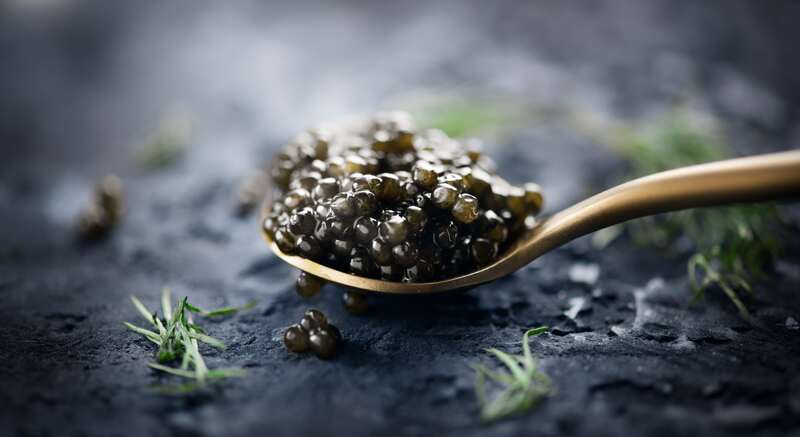
Caviar: A Culinary Delight with Scientific Insights

Introduction: Caviar is one of the world’s luxurious and renowned food items extracted from the eggs of specific fish, particularly sturgeon. This culinary delicacy is not only recognized for its sophisticated and delicious taste but also boasts abundant scientific and nutritional properties.
History of Caviar:
The history of caviar is a tale that spans centuries, with this luxurious delicacy having traversed diverse cultures and regions. Here’s a brief overview of the captivating history of caviar:
- Ancient Times: The consumption of fish roe, the precursor to caviar, dates back to ancient times. Historically, various cultures, including the Greeks, Romans, and Persians, valued the eggs of sturgeon and other fish as a source of nutrition.
- Medieval Europe: In medieval Europe, fish roe gained popularity as a delicacy among the aristocracy. The scarcity and difficulty in obtaining sturgeon roe contributed to its exclusive association with the elite classes.
- 19th Century: The 19th century witnessed a surge in the demand for caviar, particularly in Europe. Russian and Iranian caviar, sourced from the Caspian Sea, became highly coveted. Caviar became a symbol of opulence and refinement, with its consumption reserved for grand occasions.
- Industrialization and Overfishing: As industrialization progressed, the technology for fishing and processing caviar advanced. However, this period also saw a decline in sturgeon populations due to overfishing, habitat degradation, and pollution.
- Caviar Production: In response to the decline of wild sturgeon populations, efforts were made to establish sturgeon farms for sustainable caviar production. Countries like Iran, Russia, and others took initiatives to regulate and manage caviar production to ensure the conservation of sturgeon species.
- Contemporary Era: Today, caviar is produced not only in its traditional Caspian Sea region but also in other parts of the world, including the United States and China. Sustainable farming practices and conservation efforts continue to be critical for the preservation of sturgeon species.
- Global Popularity: Caviar has transcended its European origins and has become a global culinary phenomenon. It is no longer limited to exclusive gatherings of the aristocracy but is enjoyed by a broader audience with an appreciation for fine dining.
- Challenges and Conservation: Despite advancements in sustainable farming, the sturgeon species still face challenges. Conservationists and environmentalists emphasize the importance of responsible caviar production to protect the delicate balance of aquatic ecosystems.
In conclusion, the history of caviar reflects its transformation from an ancient food source to a symbol of luxury and refinement. As it continues to evolve, the story of caviar intertwines with the ongoing efforts to preserve the sturgeon species and ensure the sustainability of this exquisite culinary delight.
Sources of Caviar:
Caviar is primarily extracted from the eggs of fish such as sturgeon. Sturgeon, belonging to the Acipenseridae family, produces the highest amount of caviar. Industrial caviar production and aquaculture activities are prominent in various countries, including Russia, Iran, Kazakhstan, and Azerbaijan.
Nutrient Composition:
Caviar is hailed as a nutrient-rich food due to its abundant composition of protein, vitamin D, vitamin B12, omega-3 fatty acids, selenium, and phosphorus. These nutritional elements make caviar a recommended and healthy dietary choice.
The production of caviar involves extracting the roe (eggs) from specific fish, with sturgeon being the primary source. Here are the main sources of caviar:
- Sturgeon: Sturgeon is the most traditional and prolific source of caviar. Belonging to the Acipenseridae family, various sturgeon species such as Beluga, Osetra, and Sevruga are prized for their roe. Sturgeon caviar is renowned for its large, distinct eggs and unique flavor profiles.
- Beluga Sturgeon (Huso huso): Beluga sturgeon, the largest freshwater fish globally, produces some of the most sought-after and expensive caviar. The eggs are known for their size, delicacy, and a creamy, buttery taste.
- Osetra Sturgeon (Acipenser gueldenstaedtii): Osetra caviar comes from the Osetra sturgeon and is esteemed for its medium to large-sized eggs with a nutty, briny flavor. The color of the eggs can range from golden yellow to dark brown.
- Sevruga Sturgeon (Acipenser stellatus): Sevruga caviar is sourced from the Sevruga sturgeon, known for its smaller-sized eggs and distinct, bold flavor. The color of Sevruga caviar ranges from gray to black.
- Siberian Sturgeon (Acipenser baerii): Caviar from the Siberian sturgeon is often considered a more sustainable option. Siberian sturgeon caviar has medium-sized, dark eggs and a rich, classic caviar taste.
- White Sturgeon (Acipenser transmontanus): Native to North America, the white sturgeon is a source of caviar in the United States. White sturgeon caviar is appreciated for its mild, buttery flavor and medium to large-sized eggs.
- Sterlet Sturgeon (Acipenser ruthenus): The sterlet is one of the smaller sturgeon species and produces small to medium-sized eggs. Sterlet caviar is valued for its delicate taste and is often used in culinary applications.
- Other Fish Species: While sturgeon is the primary source, caviar can also be obtained from other fish species. For example, trout, salmon, and paddlefish are utilized to produce caviar with distinct characteristics.
It’s important to note that the production of caviar has evolved with sustainable practices, including aquaculture and sturgeon farming, to address conservation concerns and ensure the long-term viability of these fish species. Responsible caviar production aims to balance the demand for this delicacy with the preservation of sturgeon populations in the wild.
Various Uses:
Caviar, whether consumed fresh or incorporated into various dishes, serves as a delectable food item. It is also popularly used in the decoration of different dishes and during special ceremonies. Moreover, the cosmetic, culinary, and even therapeutic industries benefit from the unique properties of caviar.
Caviar, with its distinctive flavor and luxurious texture, is a versatile delicacy that finds its way into various culinary, cosmetic, and cultural applications. Here are some of the diverse uses of caviar:
- Culinary Delight:
- Consumption as a Delicacy: Caviar is often served on its own as a delicacy. It is enjoyed with minimal accompaniments like blinis, toast points, or crème fraîche to allow the rich flavor and texture of the eggs to shine.
- Gourmet Cuisine: Chefs worldwide incorporate caviar into gourmet dishes to add a touch of sophistication. It is used in salads, pasta, and seafood dishes to elevate flavors.
- Gastronomic Decoration:
- Garnish: Caviar is frequently used as a garnish to enhance the visual appeal of dishes. Its shiny, pearl-like appearance adds an elegant touch to canapés, sushi, and hors d’oeuvres.
- Ceremonial and Festive Occasions:
- Celebratory Events: Caviar is often associated with celebratory events and special occasions. Its inclusion in events like weddings, anniversaries, and New Year’s celebrations adds a sense of opulence and festivity.
- Cosmetic and Skincare Industry:
- Anti-Aging Products: Caviar extract is a sought-after ingredient in high-end skincare products. Believed to have nourishing and rejuvenating properties, caviar extract is used in anti-aging creams and serums.
- Health and Nutrition:
- Nutrient-Rich Supplement: Due to its high nutritional content, caviar is considered a valuable supplement. It provides essential nutrients such as omega-3 fatty acids, proteins, and vitamins, contributing to overall health and well-being.
- Culinary Innovation:
- Creative Cuisine: Chefs and culinary enthusiasts experiment with caviar in innovative ways, creating unique dishes that showcase its versatility. Molecular gastronomy techniques may be employed to present caviar in unexpected forms.
- Luxury Food Pairings:
- Pairing with Champagne: Caviar is often paired with champagne, creating a classic combination that highlights the effervescence of the wine and the delicate flavor of the caviar.
- Artistic Expression:
- Food Art: Caviar is sometimes used as an artistic medium in food presentations, allowing chefs to create intricate designs and patterns on plates, turning each dish into a work of art.
- Cultural Significance:
- Symbol of Prestige: Caviar continues to be a symbol of prestige and sophistication. Its association with high society and refined taste contributes to its enduring popularity in cultural contexts.
In essence, caviar’s uses extend beyond the realm of gastronomy, permeating various industries and cultural practices. Its ability to enhance flavors, textures, and visual aesthetics makes it a timeless and cherished ingredient in the world of luxury and culinary arts.
Types of caviar
- Beluga Caviar:
- Characteristics: Large eggs with a creamy and delicious flavor.
- Color: Typically golden or dark brown.
- Source: Extracted from Beluga sturgeon.
- Osetra Caviar:
- Characteristics: Medium to large-sized eggs with a nutty and nutritious flavor.
- Color: Varies from golden yellow to dark brown.
- Source: Obtained from Osetra sturgeon.
- Sevruga Caviar:
- Characteristics: Small eggs with a bold and somewhat tangy flavor.
- Color: Generally gray to black.
- Source: Derived from Sevruga sturgeon.
- Ossetra Caviar:
- Characteristics: Medium to large-sized eggs with a distinct and exquisite flavor.
- Color: Varied shades from yellow to dark brown.
- Source: Obtained from Osetra sturgeon.
- Siberian Caviar:
- Characteristics: Medium-sized eggs with a classic caviar taste.
- Color: Variable from dark to light with a black background.
- Source: Extracted from Siberian sturgeon.
- White Sturgeon Caviar:
- Characteristics: Medium to large-sized eggs with a delightful and mild flavor.
- Color: Varies from dark brown to black.
- Source: Obtained from White Sturgeon.
It’s important to note that these descriptions are general and each type of caviar may have its own unique characteristics. Additionally, due to the decline in wild sturgeon populations, responsible aquaculture and conservation efforts are crucial in the caviar industry to ensure the preservation of these natural resources.
Conclusion:
In conclusion, caviar stands as a culinary jewel with a rich history, versatile applications, and a cultural significance that transcends borders. From its humble beginnings as a food source in ancient times to its esteemed status as a symbol of luxury and refinement, caviar has evolved into a delicacy cherished worldwide. The journey of caviar mirrors the intersection of tradition and innovation, with sustainable practices playing a crucial role in its continued existence.
The various sources of caviar, primarily derived from sturgeon species, showcase the diversity of flavors, textures, and sizes that this delicacy offers. As the demand for caviar has grown, responsible production methods, including aquaculture and conservation efforts, have become integral to preserving sturgeon populations and ensuring the longevity of this exquisite culinary delight.
Beyond the realm of gastronomy, caviar finds itself in diverse applications, ranging from haute cuisine and gastronomic artistry to skincare and cultural celebrations. Its ability to enhance both the taste and aesthetics of dishes has cemented caviar’s place as a versatile ingredient in the hands of chefs and enthusiasts alike.
Caviar’s role in the cosmetic industry, with its incorporation into high-end skincare products, further demonstrates its appeal beyond the dining table. The belief in caviar extract’s nourishing and anti-aging properties has expanded its influence into the realms of beauty and wellness.
In essence, caviar’s allure lies not only in its exquisite taste but also in its ability to evoke a sense of celebration and sophistication. As we navigate the delicate balance between culinary innovation and environmental responsibility, the story of caviar continues to unfold, reminding us of the timeless allure of this exceptional delicacy. Whether served on a toast point, adorning a gourmet dish, or symbolizing opulence in cultural festivities, caviar remains a testament to the artistry, heritage, and global appreciation of fine dining.
